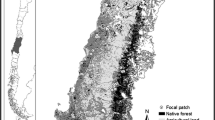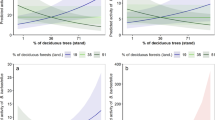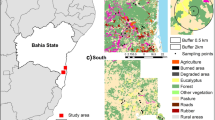Abstract
While studies have found that bat abundance is positively related to the amount of forest cover in a landscape, the effects of forest fragmentation (breaking apart of forest, independent of amount) are less certain, with some indirect evidence for positive effects of fragmentation. However, in most of these studies, the variables used to quantify fragmentation are confounded with forest amount, making it difficult to interpret the results. The purpose of this study was to examine how forest amount and forest fragmentation independently affect bat abundance. We conducted acoustic bat surveys at the centers of 22 landscapes throughout eastern Ontario, Canada, where landscapes were chosen to avoid a correlation between forest amount and forest fragmentation (number of patches) at multiple spatial scales, while simultaneously controlling for other variables that could affect bat activity. We found that the effects of forest amount on bat relative abundance were mixed across species (positive for Lasiurus borealis, negative for Perimyotis subflavus and Lasionycteris noctivagans). When there was evidence for an effect of forest fragmentation, independent of forest amount, on bat relative abundance, the effect was positive (Myotis septentrionalis, Myotis lucifugus and Lasiurus borealis). We suggest that the mechanism driving the positive responses to fragmentation is higher landscape complementation in more fragmented landscapes; that is, increased access to both foraging and roosting sites for these bat species. We conclude that fragmented landscapes that maximize complementation between roosting and foraging sites should support a higher diversity and abundance of bats.




Similar content being viewed by others
References
Agosta SJ (2002) Habitat use, diet and roost selection by the big brown bat (Eptesicus fuscus) in North America: a case for conserving an abundant species. Mamm Rev 32(3):179–198
Bernard E, Fenton MB (2007) Bats in a fragmented landscape: species composition, diversity and habitat interactions in savannas of Santarem, Central Amazonia, Brazil. Biol Conserv 134:332–343
Brigham RM (2007) Bats in forests: what we know and what we need to know. In: Lacki MJ, Hayes JP, Kurta A (eds) Bats in forests. The Johns Hopkins University Press, Baltimore, pp 1–16
Broders HG, Forbes GJ, Woodley S, Thompson ID (2006) Range extent and stand selection for roosting and foraging in forest-dwelling northern long-eared bats and little brown bats in the greater Fundy ecosystem, New Brunswick. J Wildl Manage 70(5):1174–1184
Carter TC, Menzel MA, Chapman BR, Miller KV (1999) Summer foraging and roosting behavior of an eastern pipistrelle, Pipistrellus subflavus. Bat Res News 40:5–6
Cosson JF, Pons JM, Masson D (1999) Effects of forest fragmentation on frugivorous and nectarivorous bats in French Guiana. J Trop Ecol 15:515–534
Crawley MJ (1993) GLIM for Ecologists. Blackwell, London
Duchamp JE, Swihart RK (2008) Shifts in bat community-structure related to evolved traits and features of human-altered landscapes. Landscape Ecol 23:849–860
Dunning JB, Danielson BJ, Pulliam HR (1992) Ecological processes that affect populations in complex landscapes. Oikos 65(1):169–175
Elmore LW, Miller DA, Vilella FJ (2005) Foraging area size and habitat use by red bats (Lasiurus borealis) in an intensively managed pine landscape in Mississippi. Am Midl Nat 153(2):405–417
Erickson JL, West SD (2002) The influence of regional climate and nightly weather conditions on activity patterns of insectivorous bats. Acta Chiropt 4(1):17–24
Erickson JL, West SD (2003) Associations of bats with local structure and landscape features of forested stands in western Oregon and Washington. Biol Conserv 109:95–102
Estrada A, Coates-Estrada R (2002) Bats in continuous forest, forest fragments and in an agricultural mosaic habitat-island at Los Tuxtlas, Mexico. Biol Conserv 103:237–245
Fahrig L (2003) Effects of habitat fragmentation on biodiversity. Annu Rev Ecol Syst 34:487–515
Furlonger CL, Dewar HJ, Fenton MB (1987) Habitat use by foraging insectivorous bats. Can J Zool 65(2):284–288
Gehrt SD, Chelsvig JE (2003) Bat activity in an urban landscape: patterns at the landscape and microhabitat scale. Ecol Appl 13:939–950
Gorresen PM, Willig MR (2004) Landscape responses of bats to habitat fragmentation in Atlantic forest of Paraguay. J Mammal 85(4):688–697
Grindal SD (1996) Habitat use by bats in fragmented forests. In: Barclay RMR, Brigham RM (eds) Bats and Forests Symposium, Victoria, British Columbia, 19–21 October 1995
Grindal SD (1999) Habitat use by bats, Myotis spp., in Western Newfoundland. Can Field Nat 113(2):258–263
Haila Y (2002) A conceptual genealogy of fragmentation research: from island biogeography to landscape ecology. Ecol Appl 12(2):321–334
Harris S, Cresswell WJ, Forde PG, Treshella WJ, Woollard T, Wray S (1990) Home-range analysis of problems and techniques particularly as applied to the study of mammals. Mammal Rev 20(2):97–123
Humphrey SR (1975) Nursery roosts and community diversity of Nearctic bats. J Mammal 56(2):321–346
Hutchinson JT, Lacki MJ (2000) Selection of day roosts by red bats in mixed mesophytic forests. J Wildl Manage 64:87–94
Kurta A, Baker RH (1990) Eptesicus fuscus. Mamm Species 356:1–10
Law BS, Dickman CR (1998) The use of habitat mosaics by terrestrial vertebrate fauna: implications for conservation and management. Biodivers Conserv 7(3):323–333
Law BS, Anderson J, Chidel M (1999) Bat communities in a fragmented forest landscape on the south-west slopes of New South Wales, Australia. Biol Conserv 88:333–345
Li H, Reynolds JF (1995) On definition and quantification of heterogeneity. Oikos 73(2):280–284
Loeb SC, O’Keefe (2006) Habitat use by forest bats in South Carolina in relation to local, stand and landscape characteristics. J Wildl Manage 70(5):1210–1218
Lumsden LF, Bennett AF (2005) Scattered trees in rural landscapes: foraging habitat for insectivorous bats in south-eastern Australia. Biol Conserv 122:205–222
McGarigal K, Cushman SA (2002) Comparative evaluation of experimental approaches to the study of habitat fragmentation effects. Ecol Appl 12(2):335–345
McGarigal K, McComb WC (1995) Relationships between landscape structure and breeding birds in the Oregon Coast Range. Ecol Monogr 65:235–260
Morris AD, Miller DA, Kacounis-Rueppell MC (2010) Use of forest edges by bats in a managed pine forest landscape. J Wildl Manage 74(1):26–34
Nupp TE, Swihart RK (2000) Landscape-level correlates of small-mammal assemblages in forest fragments of farmland. J Mammal 81:512–526
O’Keefe JM, Loeb SC, Lanham JD, Hill HS Jr (2009) Macrohabitat factors affect day roost selection by eastern red bats and eastern pipistrelles in the southern Appalachian Mountains, USA. For Ecol Manage 257(8):1757–1763
Patriquin KJ, Barclay RMR (2003) Foraging by bats in cleared, thinned and unharvested boreal forest. J Appl Ecol 40(4):646–657
Russo D, Jones G (2002) Identification of twenty-two bat species (Mammalia: Chiroptera) from Italy by analysis of time-expanded recordings of echolocation calls. J Zool 258:91–103
Schulze MD, Seavy NE, Whitacre DV (2000) A comparison of the phyllostomid bat assemblages in undisturbed Neotropical forest and in forest fragments of a slash-and-burn farming mosaic in Petén, Guatemala. Biotropica 32:174–184
Shump KA Jr, Shump AU (1982) Lasiurus cinereus. Mamm Species 185:1–5
Thompson ID (2000) Forest vegetation of Ontario: factors influencing landscape change. In: Perera A, Euler D, Thompson (eds) Ecology of a managed terrestrial landscape: patterns and processes of forest landscapes in Ontario. UBC Press, Vancouver, pp 30–53
Tibbels AE, Kurta A (2003) Bat activity is low in thinned and unthinned stands of red pine. Can J Forest Res 33:2436–2442
Trzcinski MK, Fahrig L, Merriam G (1999) Independent effects of forest cover and fragmentation on the distribution of forest breeding birds. Ecol Appl 9:586–593
Tuttle MD (1976) Population ecology of the gray bat (Myotis grisescens): factors influencing growth and survival of newly volant young. Ecology 57(3):587–595
Vallan D (2000) Influence of forest fragmentation on amphibian diversity in the nature reserve of Ambohitantely, highland Madagascar. Biol Conserv 96:31–43
van Zyll de Jong CG (1985) Handbook of Canadian mammals, II, Bats. National Museums of Canada, Ottawa
Villard M-A, Trzcinski MK, Merriam G (1999) Fragmentation effects on forest birds: relative influence of woodland cover and configuration on landscape occupancy. Conserv Biol 13:774–783
Walsh AL, Barclay RMR, McCracken GF (2004) Designing bat activity surveys for inventory and monitoring studies at local and regional scales. In: Brigham RM, Kalko EKV, Jones G, Parsons S, Limpens GA (eds) Bat echolocation research: tools, techniques and analysis. Bat Conservation International, Austin, pp 157–165
Worton BJ (1987) A review of models of home range for animal movement. Ecol Model 38:277–298
Wunder L, Carey AB (1996) Use of the forest canopy by bats. Northwest Sci 70:79–85
Yates MD, Muzika RM (2006) Effect of forest structure and fragmentation on site occupancy of bat species in Missouri Ozark forests. J Wildl Manage 70(5):1238–1248
Acknowledgments
We thank C. Jones, T. Mackie and K. Wilson for their help with the fieldwork, the private landowners for providing access to their properties, all members of the GLEL for their insightful comments, and D. Bert and D. Omond for logistic support. We are also grateful to C. M. Francis, A. Morin, J. P. Metzger and an anonymous reviewer for their constructive comments. We also thank A. Adams, L. Hooton and M. B. Fenton for sharing their collection of reference bat calls. This work was supported by Natural Sciences and Engineering Research Council of Canada (NSERC) and Canada Foundation for Innovation research grants to L.F.
Author information
Authors and Affiliations
Corresponding author
Electronic supplementary material
Below is the link to the electronic supplementary material.
Rights and permissions
About this article
Cite this article
Ethier, K., Fahrig, L. Positive effects of forest fragmentation, independent of forest amount, on bat abundance in eastern Ontario, Canada. Landscape Ecol 26, 865–876 (2011). https://doi.org/10.1007/s10980-011-9614-2
Received:
Accepted:
Published:
Issue Date:
DOI: https://doi.org/10.1007/s10980-011-9614-2




